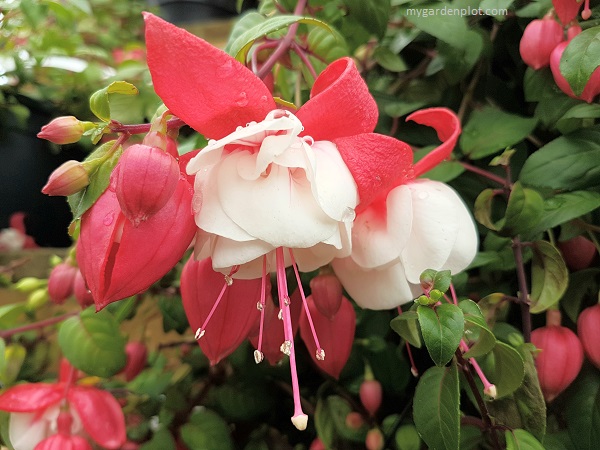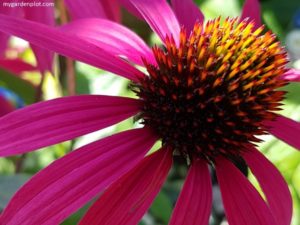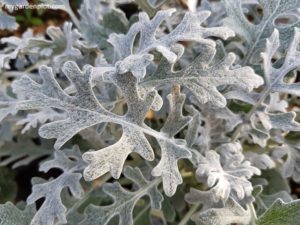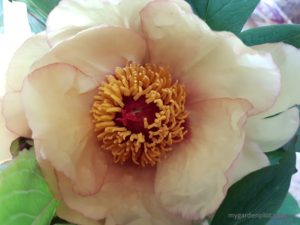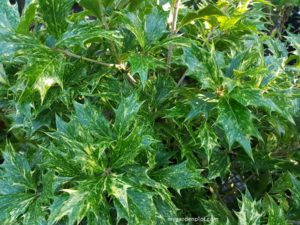Guide To Planting And Growing Fuchsias (Ladies' Eardrops)
The genus Fuchsia is a member of the evening primrose family, Onagraceae. Also known as “ladies’ eardrops” due to the pendant effect of the flower shape and hanging habit. Fuchsias produce masses of flowers in shades of pink, purple and white, with blooms that can be single, double or semi-doubles. It is one of the most reliable and popular summer flowering shrubs in the Pacific Northwest, flowering from late spring through early autumn until the first frost. As with clematis flower, the sepals are brightly coloured, and these modified leaves also give beauty to the fuchsia flower. Fuchsias are easy to care for. Below are tips for how to plant, grow and prune or overwinter your fuchsias – keeping them healthy and blooming year after year.
Fuchsias are native to Central and South America, and New Zealand. Named in honour of Leonhart Fuchs, a 16th-century German botanist, they were first revealed by the French botanist Charles Plumier around 1696–1697. Fuchsias continue to be cherished for the arching branches and masses of tropical-looking flowers. Some ornamental fuchsia shrubs are substantial, growing over three metres (10 feet) while others are trailing varieties – perfect for hanging baskets. Where to plant and how to care and prune fuchsias is divided into two groups, winter hardy fuchsias and half-hardy (semi-hardy) fuchsias.
About Hardy Fuchsias
Winter hardy fuchsias may have a delicate look, but they are anything but. They are often favoured for their summer beauty and ease of care. They are generally upright and bushy shrubs with a range of sizes. Some hardy fuchsias behave like herbaceous perennials, while others are deciduous shrubs. Our mature and reliable Fuchsia magellanica “Alba” stands over 2.5 metres (8 feet), and the slim, pale pink flowers are loved by hummingbirds and bees. It can withstand the coastal winters, and annual hard pruning to keep it in shape, generally done late winter. More about pruning hardy fuchsias below. Hardy fuchsias work well as companion shrubs along with camellias, flowering dogwood trees, and rhododendrons. If you have one of the taller hardy fuchsias, like the F. magellanica, they can provide filtered sun to lily of the valley and hostas.
About Half-hardy (Semi-hardy) Fuchsias
Half-hardy fuchsias are beautiful during the summer months. Although they are often referred to as ‘annuals,’ half-hardy fuchsias are tender perennials. This means that they are not winter hardy and cannot sustain cold winters, or even frosty weather, like their hardy counterpart. A half-hardy fuchsia can flower for more than just the summer months in a conservatory, sunroom, or greenhouse. But outdoors in colder regions, they mostly feature as a summer border plant and often used for container gardening – the trailing varieties are stunning in hanging baskets. Half-hardy fuchsias can survive the winter but only in a frost-free environment – conditions that most gardeners can easily create. More details below how to overwinter your half-hardy fuchsia.
Fuchsias At A Glance
Type: Deciduous/herbaceous perennials (hardy); Tender perennials (half-hardy)
Location: Full sun (mornings) / Part sun
Blooming Season: Summer
Size: Varies
When to prune: Early spring (see details below)
Plant Hardiness Zones: 6 – 9 (hardy fuchsias)
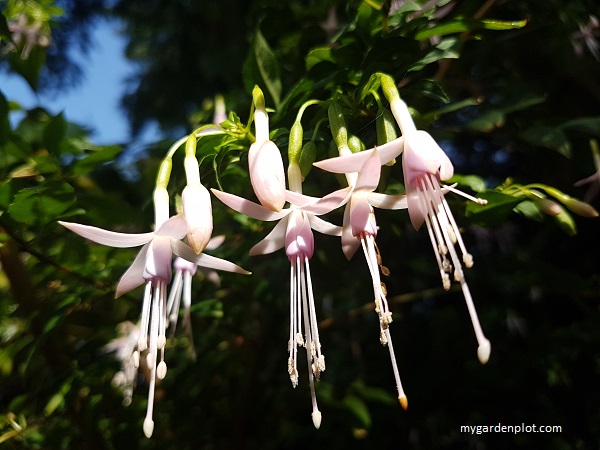
Where To Plant And How To Grow Fuchsias
Winter Hardy fuchsias are low maintenance plants. Best suited for a sunny to part sunny location. They can tolerate full sun if protected from the hot mid-day summer sun. Best is an east-facing location in full sun. They thrive in fertile, moist, well-drained soil. The best time to plant a hardy fuchsia is in the spring. When planting your fuchsia, add plenty of organic matter into the soil and regularly water it until established. New plants benefit from a light mulch before the winter to help it through its first few years. Larger plants establish quicker than smaller fuchsias. See below about pruning hardy fuchsias in early spring.
Half-hardy fuchsias make excellent summer container plants and look beautiful as a border specimen. They thrive best in a location with morning sun but sheltered from the hot summer afternoon sun. Water regularly and especially in hanging baskets to prevent drying out. Fuchsias like moist soil but do not do well when it is soggy. Ensure the container drains well. For endless masses of blossoms, fertilize with potash-rich liquid feed weekly.
How To Overwinter Half-hardy Fuchsias
Half-hardy fuchsias are not frost hardy and cannot survive outdoors during cold winters. But with the right environment, they can be overwintered where they stay dormant until the following spring. The guidelines for overwintering your half-hardy fuchsias are easy.
If your fuchsia is in the garden bed, fork up the plant in the early autumn time and plant it in a pot. It should then be placed in a cool, dry location, safe from frost. Suitable areas tend to be a basement or garage, or if you have a greenhouse that keeps to a minimum of 5C (41F). Any frost will kill your half-hardy fuchsia. Watering your fuchsias once a month should be enough to keep your plant alive why it ‘naps’. Even though it is dormant, don’t let it dry out over the winter months. The ideal indoor temperature should be around 10C (50F).
In early spring, start to bring it out of dormancy by placing your fuchsia by sheltered sunny window but away from any direct indoor heat source, as a sudden change will stress the plant too much. Once you start to see new growth, cut back the previous woody stems to a pair of healthy buds. Water as needed and begin applying liquid feed. After the last frost, you can place your fuchsia outside. Adjusting it slowly to outdoors will ensure your fuchsia returns to its full summer glory.
When And How To Prune Winter Hardy Fuchsia Shrubs
Your winter hardy fuchsia should be pruned annually after the last frost in early spring – just when you start to see new growth forming. Remove any old stems that are not growing in the right direction and pruning back to a pair of buds. Cut back all weak and thin stems. If not training as a ‘tree’ but as a shrub cut back all main stems to about 10-12 cm (4-5 inches) from the ground level. This will stimulate new growth. Our experience with healthy, hardy fuchsias are just that; they are sturdy and forgiving when pruned and thrive after being trimmed back. Do not be alarmed by the sap leaking from the cut branch after pruning your hardy fuchsia. This is a normal process that will heal.
A large fuchsia being trained as a small ‘tree’ will have a mature woody stem. It must be self-supporting, or the main stems can snap from the unbalanced weight. When we inherited a mature hard fuchsia, it was somewhat neglected and towering over us at about 2 metres (6.5 feet). It was a jumbled mess of crossing branches, and one of the two large main stems had grown nearly horizontally, causing a stress break. In early spring, we started the initial stages of remedial pruning needed. We pruned the older main woody stems down to about 1 metre (3 feet). Always cut back to where healthy buds are forming. We then removed all the deadwood, weak and thin stems at ground level. By late spring, it was flourishing again.
RELATED TOPIC: Buyer’s Guide On How To Choose Hand Pruners (Secateurs)
Tools Needed For Pruning Hardy Fuchsia Shrubs
Below is the list of essential pruning tools needed to maintain your fuchsia. Unless you have a mature, large fuchsia shrub, you may only need to have a hand pruner.
- Hand Pruners – Bypass pruners are the most popular choice for gardeners. You will be using these for cutting back the main stems of your fuchsia and pruning back to healthy pair of buds. The anvil-type pruner would be used to remove any deadwood. Remember to always keep your pruners sharp to avoid crushing the fuchsia’s hollow stems.
- Loppers – These are similar to pruners but with long handles. These are great for harder-to-reach stems and branches that you may get with mature and tall hardy fuchsias and suitable for stems that may be too thick for hand pruners.
- Pruning Saw – Pruning saws are helpful for those thick base stems growing close together, especially if you have a mature hardy fuchsia in need of remedial pruning.
- Garden Gloves – Gardening gloves help keep hands clean and provide protection. Fabric gloves with vinyl offer a good grip on the fingers and palm.


